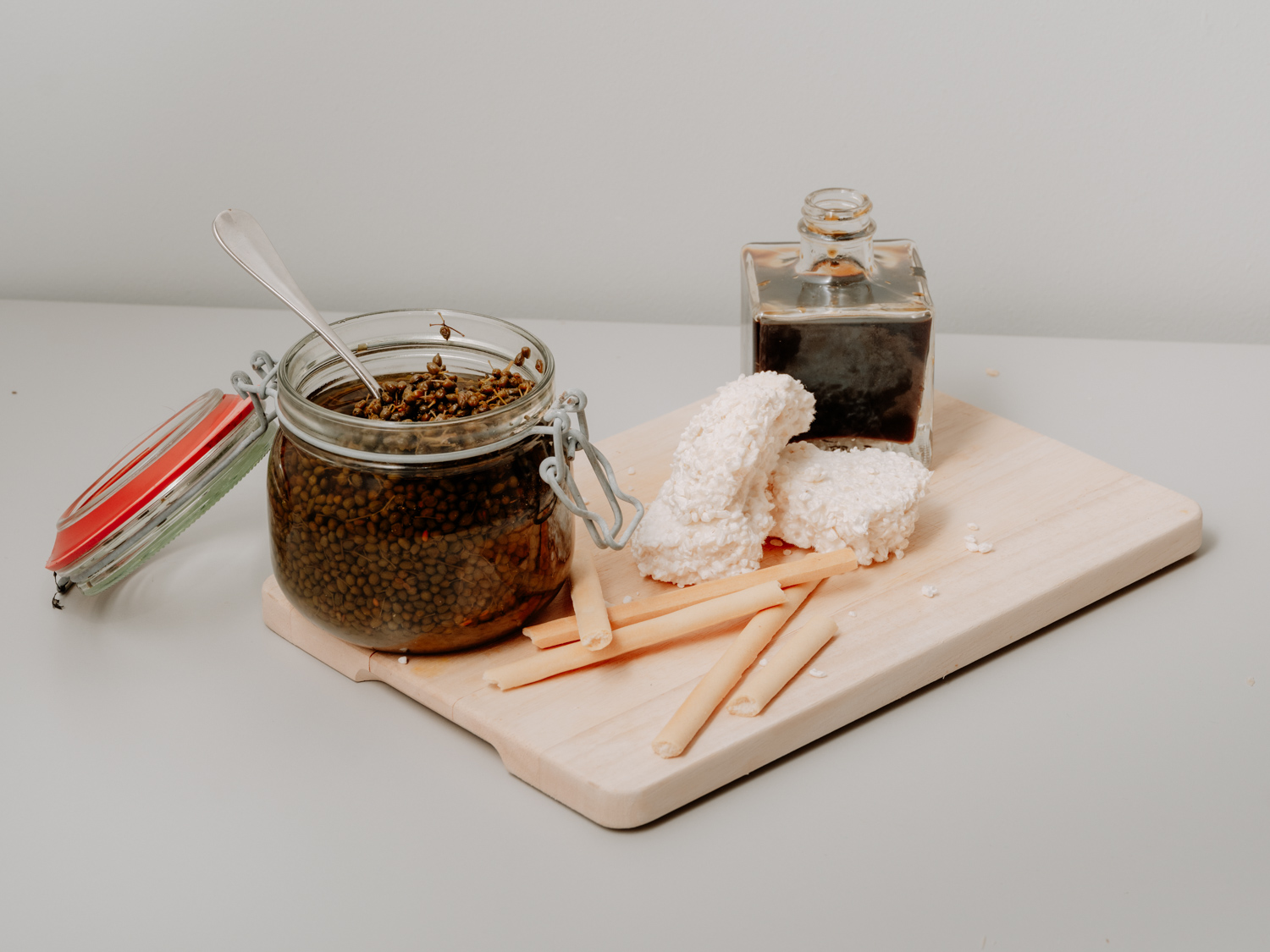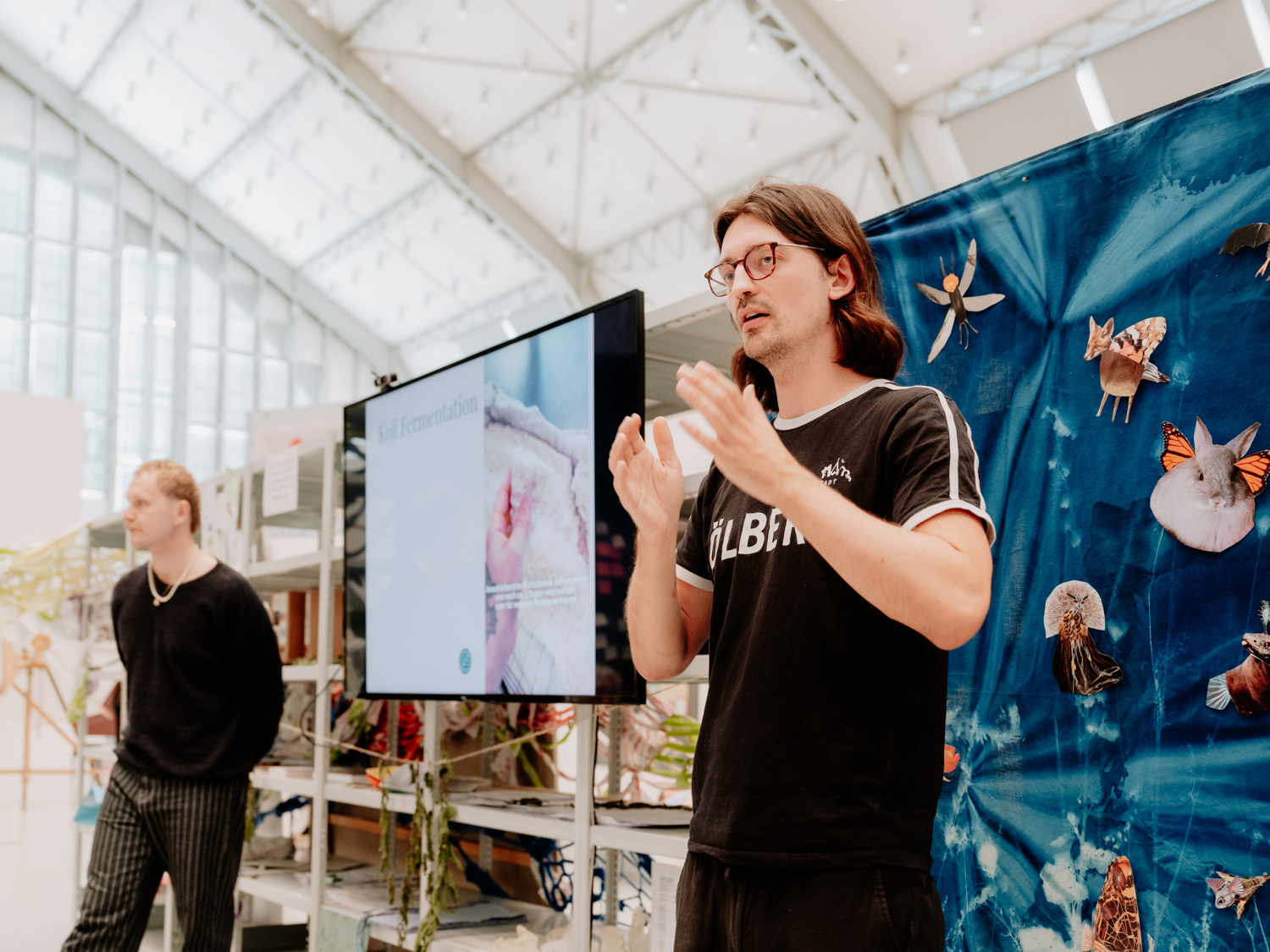Koji, Miso & Shoyu Lab
As part of his Bauhaus of the Seas fellowship project, Aaron Hasenpusch teamed up with Paul Kaufmann (Head of Fermentation at Restaurant Merold, Berlin) which has led to the start of an in-house fermentation lab at restaurant Klinker, focused on the use of koji. This will produce miso, shoyu and koji for their restaurant, as well as creating the possibility of bringing it to the private consumer. Implementing another level of depth and umami to their cuisine, it will allow an elevated expression of their dishes and display new flavours for a vegetarian cuisine.
They presented their findings on fermentation and showcased how to introduce these newfound flavors in the palate of Northern German cuisine through a lecture and tasting at the School of Survival.

A conversation between Aaron Hasenpusch, co-founder of restaurant Klinker, and Katinka Versendaal on his culinary path, ideals and ambitions, ways of working and his fellowship in the Bauhaus of the Seas program.
K: Let's start at the beginning: Klinker. How did you guys meet and what made you decide to work together?
A: We met back in 2017 when I was working in Berlin for the Michelin Star restaurant community. I met Marianus through a mutual friend - I worked with a good friend of his at the restaurant while Marianus was at another restaurant in Hotel Adlon. We connected in an after-work situation. We were both burned out from the industry and were looking to move forward. I was thinking about hospitality school, and Marianus already had a place at university for geography.
We met at this point where we both wanted to quit the industry: we were really done with the system, uncomfortable with the working hours, the behavior of our chefs, and our own behavior too. It was kind of a last call, you could say.
We decided to try some pop-ups and events together, see what people thought about our knowledge and approach to hospitality. We started with events in pop-up locations in Berlin and at Marianus’ farm. It became more and more successful.
I went to hospitality school and Marianus went to university. During our holidays, we scheduled a bigger pop-up event in Hamburg at a gallery space where many Hamburg restaurant concepts got their start. We moved in for three weeks during our break from school. We had a huge impact - the pop-up was nearly sold out the whole time and we made our first real revenues. People really responded to the concept because it was something new: regional local products in an à la carte bistro format rather than a set menu. It was a lot of fun but incredibly intense work.
After that, we went back to university. Through our growing network, we found people who could provide financial backing. I started writing our business plan - it was actually a major part of my university exam. Through this process we connected with investors who could help us get a bank credit. We found a location, brought on a restaurant manager, and everything came together.
K: Tell me about the skills you’re using today - how did you get them? You just mentioned you used the business plan as your thesis, and Marianus grew up on a Demeter farm. What other experiences shaped what you do at Klinker?
A: I’ve always been deeply interested in people and learning from different perspectives. I networked extensively in Berlin’s culinary scene. For example, I first encountered koji fermentation back in 2018, about six years ago, and it’s been a constant thread in my work since then.
I started as a chef at 18, completed my exams in the city where I grew up. I gained experience at notable restaurants like Tim Raue, worked in South Africa, and then evolved from being purely a chef to more of a hospitality generalist. When I got to Berlin, I shifted away from the intense kitchen focus and started building a network of suppliers and connections.
K: How does the Hamburg culinary scene fit in this picture? I know you work closely with ARC; what kind of knowledge and ideas do you share with people in Hamburg?
A: We were hard to categorize when we arrived. We came from Berlin but chose Hamburg because of Marianus, his farming background and regional connections. The market in Berlin was oversaturated with concepts, while Hamburg had space to grow.
We brought our own vision: different working hours, specific product choices, and a reimagined kitchen environment. At Klinker, there’s no harsh white light in the kitchen, we play music, there’s natural light and a view of the street. We didn’t have role models; we developed everything ourselves without an existing network in Hamburg.
When Arc was starting out, they called me asking for help with their business plan. I shared everything I knew over a coffee. I helped them get started in building supply chains and networks by sharing ours with them. I’m proud to support them - they're incredibly talented young chefs, which is rare these days.
K: Tell me about your approach to suppliers, your standards. Is there a Klinker manifesto for ingredients? You shape many of them through fermentation, you work closely with suppliers like Gut Haidehof. How do you make these selections and why is fermentation so important?
A: We source mainly through personal contacts and recommendations. Over the years, we've developed a kind of circuit system where information flows to us. It's become almost like software - we get recommendations from different suppliers. We can't always follow our rule of visiting every supplier. And since we're not a Michelin Star restaurant with a set menu, we need various suppliers to cover our diverse ingredients.
After five years, we're now the first door people knock on for new regional products. We're always reflecting and evolving. For example, one of our pop-up team members worked five years for another restaurant - bringing him on was a strategic decision to share his knowledge about suppliers and techniques. We arrange knowledge transfers between kitchen teams, though we had to reschedule the next one for November.
K: Let's talk about ingredients - you make many of your own through fermentation.
A: That's a practical necessity of being a seasonal restaurant in northern Germany. Our season runs from May through October - just five months to get ingredients fresh. Beyond the basics like sauerkraut, potatoes, carrots, or apples, we need specialized knowledge and preservation methods. Lennard Hoffmann, our Head Chef, started rethinking these processes in 2021, and it's become a team achievement. These techniques help us extend the northern growing season.
K: To elaborate on this, I loved Marianus' example at the opening of the School of Survival about buying asparagus in season when it tastes and costs least, preserving it for a year until the flavor transforms - sometimes even better than fresh asparagus. But this requires a different approach to restaurant business - you're not buying Monday to serve Friday but thinking a year, or even more, ahead.
A: It takes a lot of detailed planning - tracking how many jars we need, how many are in use, and engineering the menu around it. The seasons are our clockwork, our metronome. Leonard focuses on scheduling around these natural changes.
When I talk to people from culinary schools, they shake their heads. These days every restaurant claims to work with the seasons and environment, but they fail on the details. Details matter. This often leads people to rethink their daily practices. Like putting basil mayo on the menu in January - that's impossible unless you made basil oil during summer. Otherwise, you're buying basil from Israel, which is fine, but then you have to be honest about your sustainability claims.
This is actually a problem with the Michelin system. They interviewed us but they didn't check the storage, supplier lists, or plastic use. Some two- or three-star restaurants in Hamburg make questionable choices when it comes to sustainability. We are not doing this for ratings - though it would help fill the restaurant. From a marketing perspective, we could capitalize on it, but that's not our aim.

K: Let's move to your fellowship. You, with the team of Klinker, decided to work on taking your work with fermentation to a next level and started exploring koji fermentation. Why koji?
A: It's like giving a painter new colors. Fermentation gives us a new dimension of flavor, especially for vegetable dishes. For example, it adds umami depth, it balances the sweet and sour, we can reduce sweetness levels by bringing koji in. It opens up a lot of creativity and possibilities, even more than lactic fermentation does. It is an addition to our toolbox.
K: How does koji connect to the work you do with the seasons?
A: Paul (Kaufmann) and I are presenting on September 22nd the results of our project at the School of Survival. For this, we'll make our shoyu sauce - we're doing a classic version and a spicy one with fresh chili to capture the chili season. In line with this, I'm also working on a citrus fruit project. The season is short and underexplored. Koji fermentation could help preserve these special seasons. The citrus season is as important to me as the asparagus season, but it's underappreciated. Everyone uses lemon year-round, but we've replaced it in the bar with alternatives like unripe grape juice. It would be great to have a fresh bar menu highlighting orange, lemon, and blood orange juice when they're actually in season. People notice these changes - they realize "okay, now it's citrus season, not year-round." Koji helps with this. Nature sets the seasons; we adapt to it.
K: I also believe koji plays an interesting role with timing, and an understanding of time. You have the barley harvest season for your base, a very specific time during the year, but then when making a shoyu sauce, it ferments for a year and a half, two years, and can go on developing for possibly decades. Perhaps seeing seasons not as exclusively bound to the cycle of a week, month or year, but beyond, a reoccurring theme at Klinker. My last question is glancing at the future - how are you implementing the koji project in the kitchen?
A: We're already starting. During tomato season, Lenny bought lots of tomatoes. Instead of making juice or confit, we're using lacto-fermented brine combined with koji fermentation. We're using koji water in dishes and the bar. Paul mentioned we need someone dedicated to fermentation because it requires such a high level of attention and discipline. We're introducing it gradually - using it in dressings, sauces, for marinating meat and vegetables, even with butter. Our next goal is shoyu sauce, then garum - which is magic and will help upcycle food waste. We can use it in the bar too, for amazake, in ice cubes and drinks. The creative potential is huge. We're just getting started.
K: Amazing, I can’t wait to see all that you guys will come up with. Looking forward to coming back next year and seeing how the kitchen has transformed.
